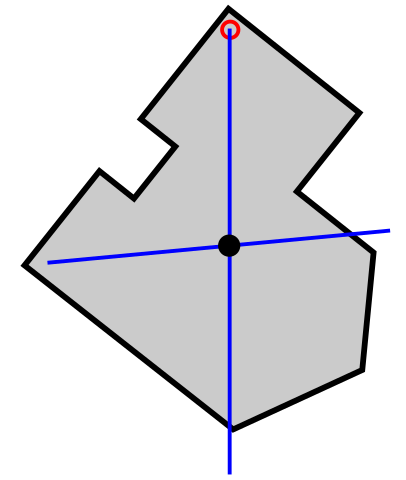
Caption: The center of mass of a rigid object can be found the hanging method as illustrated in the image.
Features:
- You hang the object from two free pivots successively.
In both cases, you allow the object to come to
rest
due to a small amount of
friction
at the pivot points.
The red dot in the image represents a free pivot.
- Each of the two hangings
is a stable equilibrium:
i.e., small perturbations from rest
cause
damped harmonic motion
that asymptotically
goes effectively to rest rather quickly.
- Analysis by
classical mechanics
shows that the
stable equilibrium
must have the object's
center of mass lying
directly below the pivot.
Only with this location for the center of mass is the gravitational torque on the object Zorro---er, zero.
- So lines drawn mentally straight downward from the two free pivots when each is used for
hanging cross at the
center of mass which is then
located---neat, eh?
The blue lines in the image represent the mentally-drawn lines.
- What if the center of mass
is directly above the pivot?
This is balancing case is an unstable equilibrium. Ideally, a vanishingly small perturbation causes the object to accelerate away from the unstable equilibrium and usually NOT return by itself.
A little bit of friction in the pivot makes the unstable equilibrium a bit metastable so that it can resist sufficiently tiny perturbations.
- What if center of mass
is right at the pivot?
This is neutral equilibrium. The object will stay at rest for any orientation it is put in.
Image link: Wikimedia Commons: File:Center gravity 2.svg.
Local file: local link: center_of_mass_hanging.html.
File: Mechanics file: center_of_mass_hanging.html.